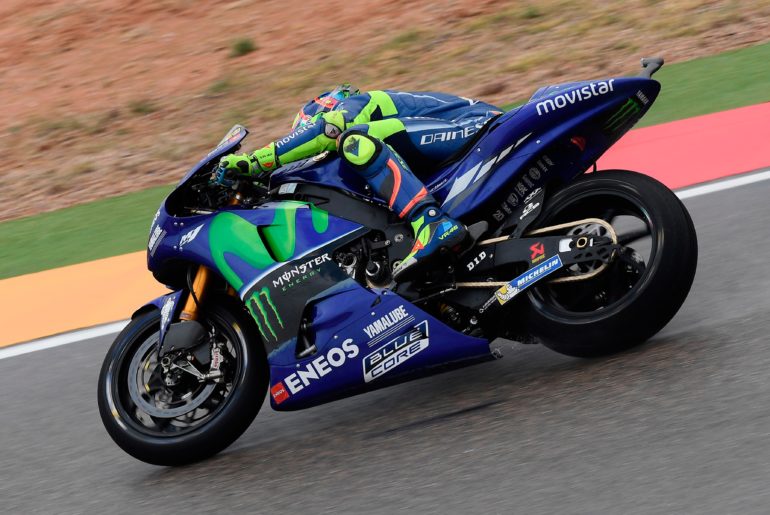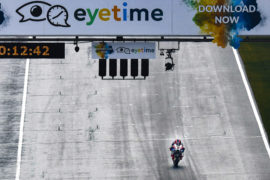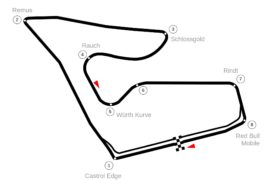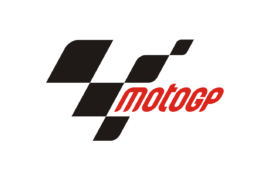I, along with almost every photographer and a good part of the journalists present at Aragon, made my way down to the pit lane on Friday morning, to watch Valentino Rossi’s first exit on the Yamaha M1 since breaking his leg in an enduro accident.
It was overcast but dry, and there was a real sense of anticipation as Rossi limped to his bike, swung his leg awkwardly over it, then exited the garage smoothly and headed off down pit lane.
Before he and the rest of the MotoGP field had reached the exit of pit lane, the rain had started to fall. Not hard enough to leave the track properly wet, but enough rain to make using slicks impossible. FP1 was a wash. Fastest man Marc Márquez was 13 seconds off lap record pace.
The track dried out again during the lunch break, but once again, just as the MotoGP riders were about to head out, the rain started to fall.
They found the track in FP2 much as they had left it in FP1: too wet for slicks, not really wet enough for a proper wet test. And with Saturday and Sunday forecast to be dry and sunny, any data collected was of very little use indeed.
Waste Not, Want Not
A wasted day? Not entirely. Time on track is intrinsically useful. And time in the wet when the rest of the weekend is expected to be dry offers an opportunity to do a little testing.
“It wasn’t a wasted day, because we wanted to take the opportunity to ride on the wet to improve,” Maverick Viñales told us. “I don’t think really we learned anything if it’s going to be dry,” Dani Pedrosa said.
“But for sure, at least we did some laps, and we get more into the track. Tomorrow we have an important session in the morning, and it’s important to be already in a good rhythm.”
That sentiment was widely shared. “Today honestly, of course it was important to ride, to get the feeling with the bike, but difficult to take conclusions or information,” Marc Márquez agreed. For Johann Zarco, it was good to go out on the wet and regain some of the confidence he had lost at Misano.
“For me it was good to have the first day in wet conditions,” the Frenchman said, “because it helps me to take it easy. When you have to be fast from the first lap in the dry, you have to discover so many things in a short time.”
But was practice on Friday of any use for the rest of the weekend? Not particularly. Few people were actually working on setup, some simply going out and riding in circles to get a feel for the track, rather than coming in and turning the bike on its head.
Others were trying to build on the results they had at Misano, when the race turned out wet. But even that turned out to be impossible, with riders’ fortunes contrasting drastically with Misano.
Misano – Aragon Seesaw
Take Dani Pedrosa and Maverick Viñales. At Misano, Viñales had had his strongest outing in the wet in MotoGP, racing to an impressive fourth place.
Pedrosa, on the other hand, had had a miserable Sunday, struggling into the points and ending the race nearly 1’40 behind the winner. Two weeks later, Pedrosa is fastest, while Viñales is floundering around in 17th, 1.7 seconds slower than the Repsol Honda rider.
Pedrosa was nonplussed by it all. Asked if he had an explanation for his contrasting results, the Spaniard was frank. “I can only tell you that the bike is the same, the tire is the same, and the rider is the same. The only thing different is the track and the place.”
If anything, it was the timing which annoyed Pedrosa most. “Obviously, it was a shame in Italy to be so terrible, but I would say the worst thing is that it was on Sunday. So today, if it was Sunday, it would be much better for us.”
In a way, it had been a relief to encounter an otherwise confounding situation. “At least we know we are fast,” Pedrosa said.
“This we know, so the next time these things happen, we know it’s not really a rider’s fault or a mechanic’s fault or the bike’s fault. We know it’s some external thing that is not really working in the way that it should be.”
Weirdness Is Worse When You Are Slow
Of course, it is easy to resign yourself to a situation when you end the day as the fastest rider, and the only one to crack the two-minute barrier. Things are tougher to accept when you are languishing in the bottom quadrant of the timesheets.
“Really difficult,” Maverick Viñales said, exasperated. “Honestly, we are very frustrated. In Misano we did a lot of steps forward with the bike in the wet. I was feeling good, especially with the front.”
“But here, the whole bike becomes difficult, especially on acceleration there is no grip and so much spin, no traction. So it becomes so difficult to make a lap.”
Finding solutions was imperative, Viñales told us. “We are trying to improve, we are trying many different things, many set ups. You always try to improve on the wet, as it’s also an important part of the game.”
“There are also some races now like Japan, Australia, Malaysia which can be wet races, so if we are not competitive like we are here, then the championship is gone, so we need to improve.”
Fortunately for the Movistar Yamaha rider, there was one Yamaha bike at the front. “We have Zarco who is in the front,” Viñales said, referring to the third fastest time set by the Monster Tech 3 Yamaha rider.
“So we have good data, so now we have to analyze where we are losing so much. It’s important that Zarco is also in the front, so we can compare the bikes really well, and see. But it’s strange, in Misano, I was in the front, and here I’m on the back.”
There was clearly no consistency among the Yamaha men, Jonas Folger struggling not with drive grip like Viñales, but with mid corner turning of his 2016 Yamaha M1.
The problem for him, the German explained, was in braking: Zarco was using the rear brake more, and getting the bike stopped better, which was helping him to turn. Folger was trying to get his head around that concept.
Positive Despite It All
Valentino Rossi, of course, finished even further behind. The factory Yamaha rider was a lowly twentieth, two seconds behind Pedrosa. But Rossi, back from injury so soon, was very far from frustrated.
“It is a positive day, because I feel good on the bike,” Rossi told us. He felt more comfortable on his M1 MotoGP bike than he had on the standard Yamaha R1 road bike. “I feel quite comfortable, also because the position on the bike is good, it helps me a bit, better than the R1. So I can ride without a lot of pain.”
Even better, his leg was not showing any signs of swelling up after two practice sessions, a sign it was holding up very well indeed. But riding in the wet was one thing, riding in the dry could turn out to be very different.
“For sure in the dry, it’s a lot more demanding, for the leg and also for all the rest. Because what I found in Misano is I have a bit more effort on the arms, on the shoulder, because in braking, I don’t have the power in the leg to brake the bike, so it’s a bit more demanding.”
“The other thing is that in the dry, you have to move on the bike more from one side to the other, and also when you are full lean, you are a bit more outside the bike.”
So riding in the wet had been a good way to ease himself back into MotoGP after breaking both tibia and fibula, but it had not necessarily been easy.
“On the wet, for sure, physically it’s a lot more easy, so it can help me to start the weekend. But on the other side, it’s more dangerous, it’s easier to make a small mistake and make a crash. So I have always to ride with some margin. You have to always keep paying attention,” Rossi said.
Will Valentino Rossi be able to race? The Movistar Yamaha rider is assuming that he will be able to, and planning his weekend accordingly. What he won’t be doing is a race-length run, to preserve what strength he has in his leg.
“For me, if I have 23 laps in my leg, maybe it’s better that I keep them for Sunday!” Rossi joked. “And during the practice, especially if it’s dry, you have a lot to do.”
Lessons for the Taking
So what did we learn at Aragon on Friday? Not a great deal, though there are still a few hints. Marc Márquez is fast in the wet, and at one of his favorite tracks, he is probably fast in the dry as well.
Jorge Lorenzo is a man to be feared: second fastest in conditions which would normally leave his knees knocking loud enough to drown out the noise of Lower Aragon’s Route of the Drums.
Since Ducati gave him the aerodynamic support he so craved, he has been knocking on the door of a strong result. Luck and circumstance have denied him so far, but that cannot last for long.
The rain also gave some of MotoGP’s more usual backmarkers a chance to shine. Sam Lowes, who Aprilia bumped out after the first year of a two-year contract, ended Friday in seventh, ahead of his normally more competitive teammate.
Bradley Smith, who has been under threat of losing his ride to KTM test rider Mika Kallio, was quicker than the Finnish rider on Friday.
Noises emerging from the KTM garage suggest that Smith’s ride is now safe, the Austrian factory having decided to give Smith a second chance, but beating Kallio can surely only help.
We also learned a thing or two off the track. Speaking to senior Dorna and IRTA officials, it is clear that there are changes afoot when it comes to testing. A proposal has been made, which will be discussed by both IRTA and the Grand Prix Commission at the Japanese round of MotoGP at Motegi.
With the calendar expanding to nineteen races for 2018, some form of testing restrictions were inevitable. Though there will be three preseason tests in 2018, the number of test days will be limited.
Contracted riders will not be able to test for all nine days of preseason testing, though some form of concession will be available to rookies in the MotoGP class.
Testing at a circuit ahead of the race, as several factories have done multiple times this year, will also be banned, though the details are still to be worked out.
The sticking point is the factories in MotoGP. The manufacturers are pushing for more testing because they are already having difficulty spending their allotted budgets.
The private teams, on the other hand, are keen to see testing dropped, as every test costs them money, while every race generates income for them. Dorna and IRTA seem to have the upper hand in these negotiations, so expect some restrictions in 2018, and perhaps more still in 2019.
Photo: Yamaha Racing
This article was originally published on MotoMatters, and is republished here on Asphalt & Rubber with permission by the author.




